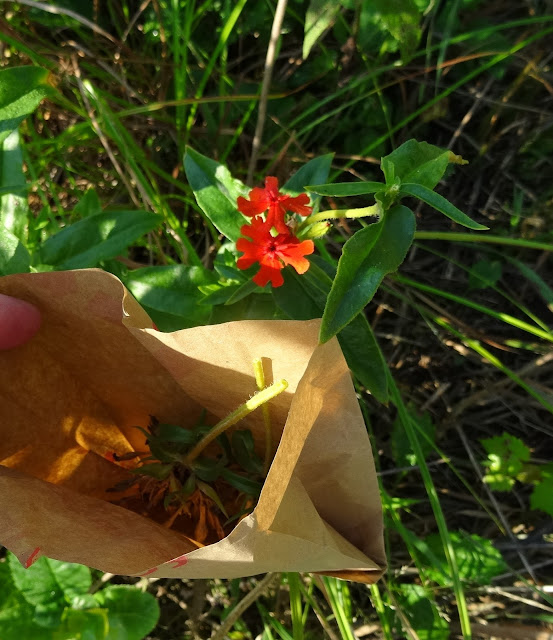This plant Eutrochium maculatum, is also called Spotted Joe-pye Weed, Purple Boneset, Spotted Trumpetweed. It is related to the similar Boneset which blooms white instead of purple or pink.
9/25/2023
7/11/2023
5/15/2023
violets by pond
10/01/2022
9/14/2022
sneezeweed
9/06/2022
vivipary = seed heads sprouting
This wildflower was finished blooming and was forming seeds. But its seed head sprouted green leaves! Fascinated, I looked closer. Some of new seeds were actually germinating and sprouting while still in the seed head. Usually, they wait until they are in the perfect place (soil, moisture, temperature, sunlight) to begin new growth. Sometimes you see this while seeds are still inside the fruit, like a tomato or green pepper. In plants, it is called vivipary (Latin for 'live birth') and involves seeds germinating before their determined time. I first learned about this a few years ago when my grandson sent me a photo of a sunflower seed head that was doing the same thing.
8/28/2022
senna
9/24/2021
boneset, golden in autumn
9/23/2021
vervain, golden in autumn
9/22/2021
golden alexanders, golden in autumn
Among the yellow, purple, and white flowers in the riparian area surrounding the pond, the Golden Alexanders Zizia aurea have long gone to seed.
They bloomed a sunny yellow in May and June. Now, the seeds still stand in umbels on strong stems. The entire plant material remaining turns a golden purple-tinged color -- lovely among the autumn asters.
9/20/2021
purple asters
9/12/2021
bee on asters
The asters are abuzz with pollinators. While standing among the wildflowers, I hear the buzzing as loud and pleasant. There are many Panicled Aster Symphyotrichum lanceolatum plants in the riparian area around the pond. The nectar and pollen of the flowerheads attract many kinds of insects, including honeybees, bumblebees, wasps, flies, butterflies, skippers, and beetles. I have not seen any Wild Turkey here, but they feed on the seeds and foliage of aster plants. Maybe some day . . .
8/06/2021
bugs by the pond

8/02/2021
blue vervain
7/31/2021
maltese cross
A volunteer plant in the area around the pond - - Maltese Cross.
7/23/2021
mountain mint
7/17/2021
royal catchfly
Royal Catchfly Silene regia makes its bright red flowers stand out among the white and purple wildflowers now blooming.
This family of plants was named 'catchfly' because it has a sticky seed pod behind the flower. Little flies, gnats, and other tiny insects get stuck on the sticky pod or stem.
Butterflies also pollinate this wildflower.
6/20/2021
crown vetch
A creeping plant that was used in the past as erosion control on embankments and roadsides, Crown Vetch Securigera varia is sprinkled among the grasses and rushs around the pond. Pretty lavender and purple blossoms among the greens, but it can take over native plants in this area.
Since this is a non-native invasive plant that can compete with native wildflowers, we will be removing it or cutting it back.
6/14/2021
6/01/2021
northern blue flag
Iris versicolor, the Northern Blue Flag, is blooming near the pond. It does not mind having its 'feet' wet and often grows in a few inches of water.
The blue to purple flowers stand out from the grasses and reeds around it, but the sword-like leaves blend into all that green!
This plant attracts both butterflies and hummingbirds, and may be known as Blue Flag Iris, Harlequin Blue Flag, Northern Iris, and Wild Iris.





















